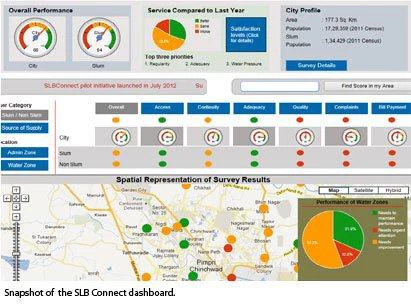Is there a model to track citizen experience of water services and present it in a ready-to-use manner for decision makers and the public? Would better articulation of citizen preferences encourage more meaningful engagement with service providers?

Recently I spent a lot of time working with the Government of India on the Service Level Benchmarking (SLB) Connect project, which is using ICT technologies to systematically capture the feedback of water service customers in India’s urban areas.
Given that more than 30% of India’s population lives in urban areas and for the first time the decadal population increase was higher in urban than rural areas, access to basic services such as water supply and sanitation is under pressure, in particular quality of access. Public providers, who account for over 95% of service provision in urban areas, typically lack customer orientation and accountability for service delivery. The result is a growing disconnect between planning and service outcomes, and between providers and citizens.
Built on the Ministry of Urban Development’s (MoUD) Service Level Benchmarks program, the goal of SLB Connect is to engage citizens in monitoring the performance of urban water suppliers and encourage them to demand better services. In the last year many good questions were asked, which I have compiled here, given their applicability across regions and sectors, together with the responses. Please feel free to submit your own questions in the comments below and I’ll do my best to answer.
Q: Is there any role for citizen engagement where service providers have poor service orientation and accountability?
A: It is likely that citizens are not interested in engaging with the service provider in such an environment. Nonetheless, citizen engagement measures are essential to strengthen pressures for change, and develop improvement plans that are based on citizen needs and priorities. Moreover, several improvement measures require the support of citizens (e.g. loss reduction, metering), for which providers need to reach out to citizens and demonstrate their credibility of intent while inviting the cooperation of citizens.
Q: Can citizen surveys help bridge the credibility gap between citizens and providers?
A: Yes, citizens can feel reassured that their views are articulated and heard, creating a common starting point for both sides to undertake meaningful dialogue.
Q: Why use ICT? Weren’t there surveys already being conducted using more traditional methods with wider reach to poorer citizens?
A: Citizen Report Card exercises were implemented in several cities. These exercises have however tended to be few and far between as they are time consuming and costly. They require considerable investment of time and effort by experts to coordinate data processing, analyze the findings and prepare the survey report. Through the use of ICTs it is possible to significantly reduce the time, cost, and technical resource requirements for undertaking such exercises. For instance, under SLB Connect, it is possible to complete the survey and analysis within 1-1.5 months, while a similar exercise using conventional paper-based methods could take 7-10 months. Stronger real-time quality checks also allow for a more credible survey process, which is not possible in a paper-based exercise.
Q: Can regular tracking and reporting on service levels from the demand side create pressures for better supply-side reporting?
A: Through well-structured citizen feedback tools, it is possible to get performance metrics that closely mirror supply-side metrics (eg access, continuity, complaints redressal). They provide an estimation of service levels. It is then incumbent on service providers to accept these results or provide counter data to prove it otherwise. In the SLB Connect exercise, it was found that the duration of supply per citizen feedback was 3 hours, while the service provider was reporting 6 hours. This created pressures on the provider to justify their reported number.
Q: Can we capture citizen feedback through complaints monitoring data, or self-reported feedback?
A: When service provider credibility is low, citizens are not likely to engage directly with the provider - at least through formal channels (e.g. in the SLB Connect survey conducted for one city, only 21% of the complaints were lodged through formal channels; 74% were through the local councilor). Self-reporting also tends to be limited since there is low expectation of response from the provider. This implies that relying on complaints data (limited to formal channels) or self-reported data would provide an incomplete picture of service levels. A survey process is needed to obtain feedback from citizens.
Q: Can granularity of data at intra-city level help reduce service inequities within the city?
A: Currently in the Indian context there are no tools to systematically track and report performance at the intra-city level (e.g. ward, water zone). This is regrettable because by providing this data, service inequities are made more explicit, creating pressure on service providers to address these. For example, in the SLB Connect exercise, the feedback on water quality (% of respondents reporting no dirty water supply from municipal source during last 3 months) varied significantly across users of different water sources - 52% for individual/shared connections as against just 27% for standposts and handpumps. Availability of such data at a granular level can also help isolate responsibility, and thereby empower city managers to extract greater accountability from their staff.
Q: Does the reduction in time lag between survey and results dissemination help increase citizen/ stakeholder engagement?
Yes, in two ways – 1.) By making the process easier to undertake, it becomes more feasible to obtain regular feedback and hence facilitate on-going citizen engagement activities. 2.) By reducing the time lag, the data is more current and hence more relevant for stakeholders. This can strengthen stakeholder interest in the feedback process and foster dialogue on the findings.
Q: Does the format and platform for presenting feedback data make a difference to levels of engagement?
A: Citizen feedback surveys typically result in paper reports (usually bulky) that are often inaccessible to a wider audience, and too dense even for those who have access. Feedback needs to be presented in a more intuitive manner and readily accessible on public platforms.
For more information on SLB Connect, see Using Technology to Track How Citizens Experience Water Service Delivery in India.


Join the Conversation